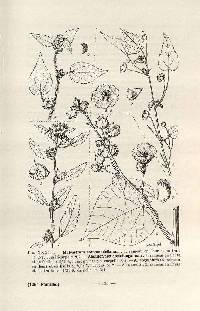
Indigenous
Local names: Rwa: Umuhatura, Umukungeri. Umushoshwe.
Common names: Eng: Old man’s gold. Swa: Muumanda.
Description: Abutilon angulatum is a woody herb of 2-3 m high with purple-red-grey-green young stems, sometimes 3-angled when mature.
Bark: Grey, smooth and fibrous.
Leaves: Alternate, oval to cordate, grey-green, hairy on both sides, green on the upper side and paler below.
Flowers: Orange-yellow with 5 lobes joined at the base, sepals form a green furry cup with 5 short triangular lobes.
Fruits: The dry dehiscent fruits (carpels) of A. angulatum are yellow, cylindrical and hairy about 15 mm in diameter, containing many seeds in the calyx.
Geographical distribution and ecological requirements: A. angulatum is widespread in Eastern, Central and South Africa. It grows in disturbed ground, open or closed woodland, riverine and grassland, from 100-2700 m. In Rwanda, this species grows in similar habitat and has been recorded in Musanze and Akagera National Park, at 1350-1640 m within areas receiving the total rainfall ranging from 499-1965 mm.
Uses: In Rwanda, local communities use A. angulatum leaves as an important source of medicine against diarrhoea while the whole plant is used for ornamental purposes. In Tanzania, young leaves and flowers are used as a vegetable while roots can be used as medicine for cough. Also, the stem bark is used in making string while flowers are a good source of bee forage.
Propagation: This species can be propagated using freshly collected seeds.
Seed information:Collect mature fruits by hand or secateurs from the plant, dry fruits in the sun by spreading them on polythene sheeting to allow the carpels to open and release seeds, thresh and clean the seeds before storage.
Seed storage and pre-germination treatment:Seed pre-treatment is not required, use fresh and sound seeds to ensure fast-growing, healthy and high productive plantations. High quality seeds stored in airtight sealed containers can retain viability for several years.
Management: This species coppices well and can easily be propagated by direct seed sowing.
Remarks: The species is known to be a bad weed in farms.
Copyright (c)2020. Data portal development has been supported through the cooperation of Biocultural Diversity International and the National Herbarium of Rwanda (NHR)
at the Center of Excellence in Biodiversity and Natural Resources Management (CoEB).
We are currently actively seeking additional funding for this project.
Powered by Symbiota software with site management and data curation support by Michael B. Thomas, PhD. Usage Policy.







